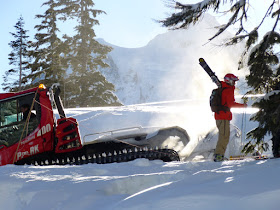This winter I've been pushing myself a bit at the rock gym.
As many of you know, I used to be the lead Red Rock Guide for the
American Alpine Institute, which meant that I got to rock climb pretty much every day throughout the Red Rock season. In 2008, I was promoted to a management position at the Institute and moved up to Bellingham. Now my winter seasons are far more dominated by skiing than by rock climbing...
With that in mind, this winter I felt that I needed to get into better rock shape before heading down to Vegas for a long stint of guiding in the spring. I've been wearing an absolutely spectacular all around shoe for both my long days out on the rock as well as for my gym sessions. I've had a pair of
Five Ten Newtons for the last couple years and have really enjoyed them.
Honestly, I'm not much of a gym climber, so this shoe might not be the best choice for your standard gym session. Instead, the shoe was designed for long multi-pitch lines and crack climbs, the types of things I do the most. The Newton is very stiff, perhaps one of the stiffest shoes that Five Ten offers. It has a supportive midsole, and a very cushy feel from the lined uppers and the padded tongue.
I've worn the shoe on dozens of multi-pitch lines in places like
Red Rock Canyon,
Squamish,
Leavenworth and on alpine routes in the
North Cascades. In every instance the shoe performed extremely well. With that in mind, there is a tendency to look at harder multi-pitch lines and to want a shoe that has the tight fit of a sport or bouldering shoe; but to then look at the number of pitches and the length of the day and to think that there's no way that you'd want a tight shoe. One of the nicest things about the Newton is that it has a cool lacing system, which Five Ten refers to as the S-Lacing Closure. This system allows you to crank down the shoe for the harder pitches with smaller holds, while still providing the ability to losen it up for easier terrain.
Many climbing shop employees are under the impression that you should buy climbing shoes that are two sizes too small for your feet. The thing to remember about climbing shop employees is that most them are boulderers and bouldering requires super tight shoes. I am absolutely not a fan of painfully tight shoes. However, there is some legitimacy to somewhat tight shoes.
Historically, I have bought my shoes one full size smaller than my street shoe size. Most climbing shoes tend to stretch out to a point where they end up being about a half-size smaller than my street shoe. I find this somewhat comfortable in a climbing shoe. However, when I bought the Newtons one full size too small, I couldn't get my foot in. I had to return them for a shoe that was half-a-size smaller than my street shoe, and these were still a bit tight, though they stretched out to a comfortable size rather quickly.
I have noticed that Five Ten shoes are a bit on the tight size, so be wary about ordering them online without trying them on first. Especially if you're looking to buy right before a road trip and don't have time to send them back for a larger pair.
One other important thing to note about the Newtons is that the soles are covered in Stealth Onyxx rubber, as opposed to C4. The Onyxx rubber has a higher level of durability and is supposed to be stickier. I didn't notice much of a difference as far as how sticky the shoe was under normal conditions. However, I found them to be much stickier when it was warm out. As far as durability goes, the rubber appears to be far more durable than C4. I had the shoes for over two years before I had to resole them. With most shoes it seems like I need a resole once a year.
No shoe is going to be perfect for everybody. People's feet are just as variable as their personalities and it's important to find a shoe that fits both you and the type of climbing that you enjoy. If you like long multi-pitch lines and crack climbing, with a little winter gym training thrown in every now and then, then maybe the Newton is the shoe for you...
My Newtons have a hole in them, so I'm wearing a different pair of shoes right now for my winter training. Hopefully they'll be re-soled by the time I head down to Vegas...
I need some good shoes to get after some of the long adventure lines in the desert!
Jason D. Martin


































